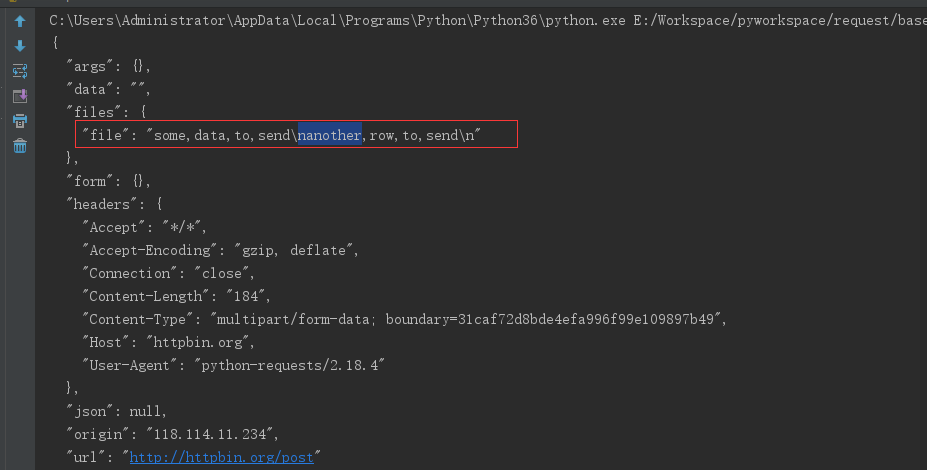1.发送请求:
import requests
# 获取数据
#r是一个 response 对象。包含请求返回的内容
r = requests.get('https://github.com/timeline.json')
print(r.content)
打印结果:
b'{"message":"Hello there, wayfaring stranger. If youxe2x80x99re reading this then you probably didnxe2x80x99t see our blog post a couple of years back announcing that this API would go away: GitHub API v2: End of Life Fear not, you should be able to get what you need from the shiny new Events API instead.","documentation_url":"Events | GitHub Developer Guide"}'
发送请求有4中方式,就是http协议的4中method:
r = requests.put("http://httpbin.org/put")
r = requests.delete("http://httpbin.org/delete")
r = requests.head("http://httpbin.org/get")
r = requests.options("http://httpbin.org/get")
2.传递 URL 参数
以下两种方式,是通过url传参。参数,必须是一个字典
import requests
payload1 = {'key1': 'value1', 'key2': 'value2'}
r1 = requests.get("http://httpbin.org/get", params=payload1)
print(r1.url)
payload2 = {'key1': 'value1', 'key2': ['value2', 'value3']}
r2 = requests.get('http://httpbin.org/get', params=payload2)
print(r2.url)
对应结果:
http://httpbin.org/get?key1=value1&key2=value2
http://httpbin.org/get?key1=value1&key2=value2&key2=value3
注意看差别
3.响应内容
r = requests.get('https://github.com/timeline.json')
#获取响应结果
print(r.text)
#获取内容编码
print(r.encoding)
#修改内容编码方式。修改之后再取text将使用新的编码方式
r.encoding = 'ISO-8859-1'

注意符号上编码不同
将内容编辑成二进制
i = BytesIO(r.content)
将内容转为JSON对象
print(r.json())
注意:成功调用 r.json() 并不意味着响应的成功。有的服务器会在失败的响应中包含一个 JSON 对象(比如 HTTP 500 的错误细节)。这种 JSON 会被解码返回。要检查请求是否成功,请使用 r.raise_for_status() 或者检查 r.status_code 是否和你的期望相同
原始响应内容
什么是原始内容?客户端和服务器端建立socket的那一层取回的内容。需要设置stream=True才能取回,返回的是urllib的对象。
r = requests.get('https://github.com/timeline.json', stream=True)
#取回流中的100个字节的内容
r.raw.read(100)

但是,若是要将返回的数据保存为文件,应这样使用流:
with open(filename, 'wb') as fd:
for chunk in r.iter_content(chunk_size):
fd.write(chunk)
用Response.iter_content替代r.raw
4.定制请求头
url = 'https://api.github.com/some/endpoint'
headers = {'user-agent': 'my-app/0.0.1'}
#说白了就给url传参数
r = requests.get(url, headers=headers)
有以下内容要注意:
注意: 定制 header 的优先级低于某些特定的信息源,例如:
如果在 .netrc 中设置了用户认证信息,使用 headers= 设置的授权就不会生效。而如果设置了auth= 参数,``.netrc`` 的设置就无效了。
如果被重定向到别的主机,授权 header 就会被删除。
代理授权 header 会被 URL 中提供的代理身份覆盖掉。
在我们能判断内容长度的情况下,header 的 Content-Length 会被改写。
更进一步讲,Requests 不会基于定制 header 的具体情况改变自己的行为。只不过在最后的请求中,所有的 header 信息都会被传递进去。
注意: 所有的 header 值必须是 string、bytestring 或者 unicode。
5.更加复杂的 POST 请求
import requests
# 传递元组
payload1 = (('key1', 'value1'), ('key1', 'value2'))
r1 = requests.post('http://httpbin.org/post', data=payload1)
# 传递字典
payload2 = {'key1': 'value1', 'key2': 'value2'}
r2 = requests.post("http://httpbin.org/post", data=payload2)
# 传递JSON字符串
url1 = 'https://api.github.com/some/endpoint'
payload3 = {'some': 'data'}
r3 = requests.post(url1, data=json.dumps(payload3))
# 传递JSON对象
url2 = 'https://api.github.com/some/endpoint'
payload4 = {'some': 'data'}
r4 = requests.post(url2, json=payload4)
6.传文件
import requests
url = 'http://httpbin.org/post'
# files = {'file': open('report.xls', 'rb')}
# 显式地设置文件名,文件类型和请求头
# files = {'file': ('report.xls', open('report.xls', 'rb'), 'application/vnd.ms-excel', {'Expires': '0'})}
# 把字符串当做文件来发送
files = {'file': ('report.xls', 'some,data,to,send
another,row,to,send
')}
r = requests.post(url, files=files)
print(r.text)
第3步响应结果
注意:官方建议使用 requests-toolbelt 发送多个文件。后面我们将进一步演示

7.响应状态码
r = requests.get('http://httpbin.org/get')
print(r.status_code)
# 状态查询对象:requests.codes
print(r.status_code == requests.codes.ok)
bad_r = requests.get('http://httpbin.org/status/404')
print (bad_r.status_code)
# 在请求有问题的时候,raise_for_status()方法会手动出发异常
bad_r.raise_for_status()
执行结果:

8.响应头
import requests
r = requests.get('http://httpbin.org/get')
print(r.status_code)
#获取响应头。响应头是字典
print(r.headers)
print(r.headers['Content-Type'])
print(r.headers.get('content-type'))
9.Cookie
import requests
url = 'http://example.com/some/cookie/setting/url'
r = requests.get(url)
# 获取请求返回的cookies
r.cookies['example_cookie_name']
url = 'http://httpbin.org/cookies'
# 把请求带上cookies 这玩意在模拟登录后经常使用
r = requests.get(url, cookies=cookies)
r.text
# Cookie 的返回对象为 RequestsCookieJar,它的行为和字典类似,适合跨域名跨路径使用
#妹的,这是跨域吗。明明是模仿免登录
jar = requests.cookies.RequestsCookieJar()
jar.set('tasty_cookie', 'yum', domain='httpbin.org', path='/cookies')
jar.set('gross_cookie', 'blech', domain='httpbin.org', path='/elsewhere')
url = 'http://httpbin.org/cookies'
r = requests.get(url, cookies=jar)
r.text
10.重定向与请求历史
默认情况下,除了 HEAD, Requests 会自动处理所有重定向。可以使用响应对象的 history 方法来追踪重定向。
什么是重定向:输入的是A地址却自动跳转到B地址
以下实例:放回的301代表永久性重定向。不要纠结过多,记住就行了。
这里需要理解:本实例明明访问一个地址,为什么就重定向了。因为访问的是域名,DNS会自动转向实际的服务器,这里就重定向了
Response.history 是一个 Response 对象的列表,为了完成请求而创建了这些对象。这个对象列表按照从最老到最近的请求进行排序。
r = requests.get('http://github.com')
print(r.url)
print(r.history)
禁用重定向:
使用GET、OPTIONS、POST、PUT、PATCH 或者 DELETE,那么可以通过 allow_redirects 参数禁用重定向处理
r = requests.get('http://github.com', allow_redirects=False)
print(r.status_code)
print(r.history)
使用HEAD启动重定向:
r = requests.head('http://github.com', allow_redirects=True)
print(r.history)
11.超时
r=requests.get('http://github.com', timeout=0.001)
超时:是非常有用的。若是不设置超时,在很长一段时间都没返回,那么程序就会阻塞。timeout 仅对连接过程有效,与响应体的下载无关。 timeout 并不是整个下载响应的时间限制,而是如果服务器在 timeout 秒内没有应答,将会引发一个异常(更精确地说,是在timeout 秒内没有从基础套接字上接收到任何字节的数据时)
12.错误与异常
遇到网络问题(如:DNS 查询失败、拒绝连接等)时,Requests 会抛出一个 ConnectionError 异常。
如果 HTTP 请求返回了不成功的状态码, Response.raise_for_status() 会抛出一个 HTTPError异常。
若请求超时,则抛出一个 Timeout 异常。
若请求超过了设定的最大重定向次数,则会抛出一个 TooManyRedirects 异常。
所有Requests显式抛出的异常都继承自 requests.exceptions.RequestException
截止目前,我们对requests有了一个基本认识。明天,我们将进一步讨论requests高级耍法。
我只希望公司的新同事,牛小妹能花点时间仔细看下,代码拿来运行下,看有什么效果。